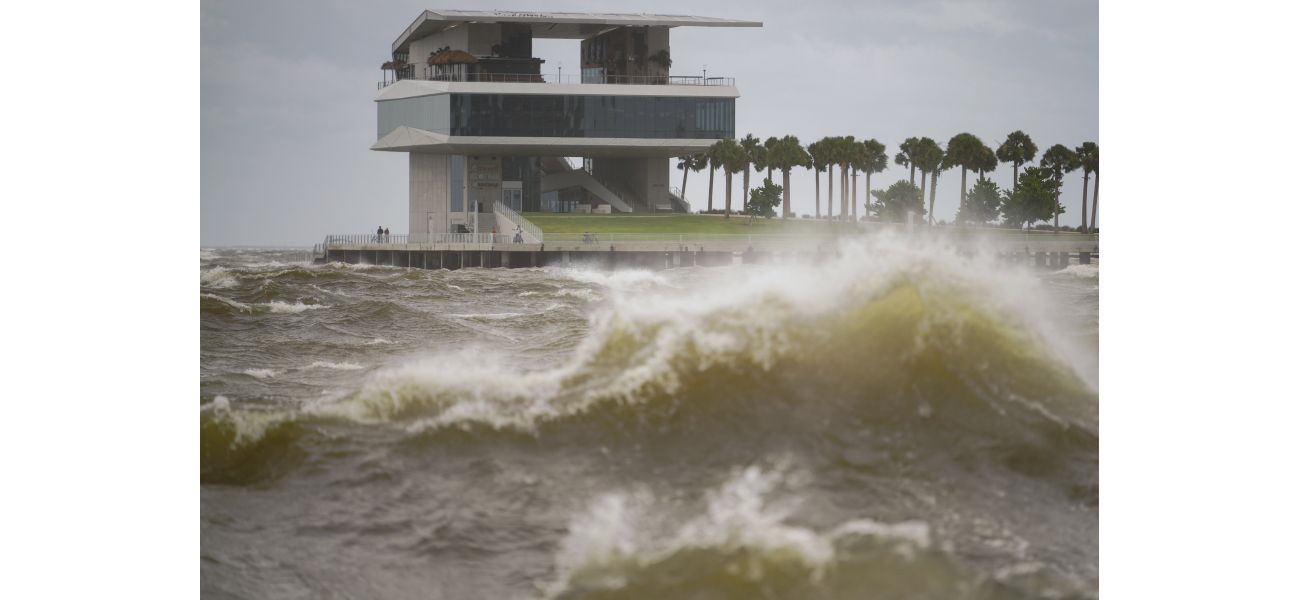Hurricane Helene hits northwestern Florida as a Category 4 storm.
Several states have declared emergencies due to powerful winds causing power outages for over 250,000 properties.
September 27th 2024.

Hurricane Helene, a fast-moving and powerful storm, has made landfall in the Big Bend area of Florida's northwestern coast on Thursday evening as a Category 4 storm. Forecasters have issued warnings of potential catastrophic storm surges, damaging winds, heavy rainfall, and flash floods that could affect a large portion of the southeastern United States.
As Helene approached, authorities in Georgia reported two deaths possibly caused by a tornado, and Florida Governor Ron DeSantis confirmed one fatality on Interstate 4 when a sign fell onto a car. The storm has also left over 1 million homes and businesses in Florida and over 50,000 in Georgia without power, according to poweroutage.us. States of emergency have been declared in Florida, Georgia, the Carolinas, Virginia, and Alabama.
Meanwhile, in the Pacific, former Hurricane John has strengthened back into a hurricane as it threatens Mexico's western coast with flash flooding and mudslides. It was then downgraded to a tropical storm as it moved along the coast of the Mexican state of Michoacan. In the Atlantic, Tropical Storm Isaac has also formed and is predicted to become a hurricane by the end of the week.
Governor DeSantis urged people to stay safe and be cautious as the storm continues to cause dangerous conditions. He also warned that there may be more fatalities and property damage as Helene advances. The National Guard has been activated to assist with the response.
Helene made landfall near Perry, Florida with maximum sustained winds of 140 mph. Officials have warned of potential storm surges of up to 20 feet, which could be catastrophic and unsurvivable. Hurricane and flash flood warnings have been issued for areas beyond the coast, including parts of Georgia and North Carolina.
The number of power outages continues to rise in Florida, with over 885,000 customers currently without power. The majority of these outages are in the Big Bend area, where Helene is expected to make landfall. Meanwhile, John, which was downgraded to a tropical storm, is slowly moving along Mexico's coast and still poses a threat of flash flooding.
The former Hurricane John initially hit Mexico on Monday as a Category 3 storm, causing significant damage. After weakening and reemerging over the ocean, it has regained strength and is expected to continue weakening before dissipating. Both Helene and John serve as reminders of the destructive power of hurricanes and the importance of being prepared and staying safe during severe weather events.
On a Thursday evening, a powerful Category 4 storm, known as Hurricane Helene, made its way towards the northwestern coast of Florida. Forecasters predicted that this fast-moving hurricane would cause a "catastrophic" storm surge and bring damaging winds, heavy rains, and flash floods to the southeastern United States. As the storm approached, authorities in Georgia reported two deaths from a possible tornado, and Florida Governor Ron DeSantis confirmed that another person had died while driving on Interstate 4 when a sign fell onto their car.
The impact of Hurricane Helene was felt far beyond the Florida coast, as it knocked out power to over 1 million homes and businesses in Florida and over 50,000 in Georgia. States of emergency were declared in Florida, Georgia, the Carolinas, Virginia, and Alabama. The situation was equally dire in the Pacific, where Hurricane John had strengthened into a hurricane once again and was threatening areas of Mexico's western coast with flash flooding and mudslides.
Meanwhile, another storm named Tropical Storm Isaac had formed in the Atlantic Ocean and was expected to become a hurricane by the end of the week as it moved away from the United States. These back-to-back storms were causing widespread concern and fear, with DeSantis urging people to stay safe and take necessary precautions.
During a news conference, DeSantis shared the tragic news of the death on Interstate 4 and emphasized the dangerous conditions that were present throughout the state. He also warned that there could be more fatalities as the storm progressed, and urged people to keep the affected individuals and their families in their thoughts and prayers. DeSantis also revealed that 3,500 National Guardsmen were on standby to assist with the aftermath of the storm.
As Helene made landfall in northwestern Florida, the National Hurricane Centre in Miami issued a warning for "catastrophic" flooding along the Gulf Coast. The storm hit the coast near Perry, Florida, with maximum sustained winds of 140 mph. Forecasters also warned of storm surges of up to 20 feet, which could be "catastrophic and unsurvivable" in Florida's Apalachee Bay. The hurricane and flash flood warnings extended beyond the coast, reaching northern Georgia and western North Carolina.
The impact of the storm was evident in the rising number of power outages in Florida, with over 885,000 customers left without electricity by 11 p.m. EDT. The majority of these outages were concentrated in the Big Bend area of Florida, where Helene had made landfall.
In the midst of all this chaos, Hurricane John continued to wreak havoc along the coast of Mexico. After initially making landfall as a Category 3 hurricane in Acapulco, it had weakened inland, only to reemerge over the ocean and reform as a tropical storm. By Thursday evening, it had been downgraded once again to a tropical storm, but it was still causing severe flash flooding in the Mexican state of Michoacan. The US National Hurricane Centre reported sustained wind speeds of 70 mph, and warned of potential damage and danger. The storm was expected to weaken further as it moved along the coast.
The events of the past few days had left many people worried and anxious, with the future of the affected areas hanging in the balance. As the storms continued to rage, the entire nation held its breath, hoping for the best and praying for the safety of those in harm's way.
As Helene approached, authorities in Georgia reported two deaths possibly caused by a tornado, and Florida Governor Ron DeSantis confirmed one fatality on Interstate 4 when a sign fell onto a car. The storm has also left over 1 million homes and businesses in Florida and over 50,000 in Georgia without power, according to poweroutage.us. States of emergency have been declared in Florida, Georgia, the Carolinas, Virginia, and Alabama.
Meanwhile, in the Pacific, former Hurricane John has strengthened back into a hurricane as it threatens Mexico's western coast with flash flooding and mudslides. It was then downgraded to a tropical storm as it moved along the coast of the Mexican state of Michoacan. In the Atlantic, Tropical Storm Isaac has also formed and is predicted to become a hurricane by the end of the week.
Governor DeSantis urged people to stay safe and be cautious as the storm continues to cause dangerous conditions. He also warned that there may be more fatalities and property damage as Helene advances. The National Guard has been activated to assist with the response.
Helene made landfall near Perry, Florida with maximum sustained winds of 140 mph. Officials have warned of potential storm surges of up to 20 feet, which could be catastrophic and unsurvivable. Hurricane and flash flood warnings have been issued for areas beyond the coast, including parts of Georgia and North Carolina.
The number of power outages continues to rise in Florida, with over 885,000 customers currently without power. The majority of these outages are in the Big Bend area, where Helene is expected to make landfall. Meanwhile, John, which was downgraded to a tropical storm, is slowly moving along Mexico's coast and still poses a threat of flash flooding.
The former Hurricane John initially hit Mexico on Monday as a Category 3 storm, causing significant damage. After weakening and reemerging over the ocean, it has regained strength and is expected to continue weakening before dissipating. Both Helene and John serve as reminders of the destructive power of hurricanes and the importance of being prepared and staying safe during severe weather events.
On a Thursday evening, a powerful Category 4 storm, known as Hurricane Helene, made its way towards the northwestern coast of Florida. Forecasters predicted that this fast-moving hurricane would cause a "catastrophic" storm surge and bring damaging winds, heavy rains, and flash floods to the southeastern United States. As the storm approached, authorities in Georgia reported two deaths from a possible tornado, and Florida Governor Ron DeSantis confirmed that another person had died while driving on Interstate 4 when a sign fell onto their car.
The impact of Hurricane Helene was felt far beyond the Florida coast, as it knocked out power to over 1 million homes and businesses in Florida and over 50,000 in Georgia. States of emergency were declared in Florida, Georgia, the Carolinas, Virginia, and Alabama. The situation was equally dire in the Pacific, where Hurricane John had strengthened into a hurricane once again and was threatening areas of Mexico's western coast with flash flooding and mudslides.
Meanwhile, another storm named Tropical Storm Isaac had formed in the Atlantic Ocean and was expected to become a hurricane by the end of the week as it moved away from the United States. These back-to-back storms were causing widespread concern and fear, with DeSantis urging people to stay safe and take necessary precautions.
During a news conference, DeSantis shared the tragic news of the death on Interstate 4 and emphasized the dangerous conditions that were present throughout the state. He also warned that there could be more fatalities as the storm progressed, and urged people to keep the affected individuals and their families in their thoughts and prayers. DeSantis also revealed that 3,500 National Guardsmen were on standby to assist with the aftermath of the storm.
As Helene made landfall in northwestern Florida, the National Hurricane Centre in Miami issued a warning for "catastrophic" flooding along the Gulf Coast. The storm hit the coast near Perry, Florida, with maximum sustained winds of 140 mph. Forecasters also warned of storm surges of up to 20 feet, which could be "catastrophic and unsurvivable" in Florida's Apalachee Bay. The hurricane and flash flood warnings extended beyond the coast, reaching northern Georgia and western North Carolina.
The impact of the storm was evident in the rising number of power outages in Florida, with over 885,000 customers left without electricity by 11 p.m. EDT. The majority of these outages were concentrated in the Big Bend area of Florida, where Helene had made landfall.
In the midst of all this chaos, Hurricane John continued to wreak havoc along the coast of Mexico. After initially making landfall as a Category 3 hurricane in Acapulco, it had weakened inland, only to reemerge over the ocean and reform as a tropical storm. By Thursday evening, it had been downgraded once again to a tropical storm, but it was still causing severe flash flooding in the Mexican state of Michoacan. The US National Hurricane Centre reported sustained wind speeds of 70 mph, and warned of potential damage and danger. The storm was expected to weaken further as it moved along the coast.
The events of the past few days had left many people worried and anxious, with the future of the affected areas hanging in the balance. As the storms continued to rage, the entire nation held its breath, hoping for the best and praying for the safety of those in harm's way.
[This article has been trending online recently and has been generated with AI. Your feed is customized.]
[Generative AI is experimental.]
0
0
Submit Comment





